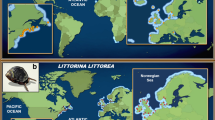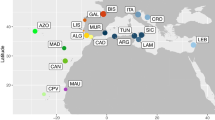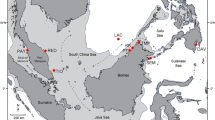Abstract
In the marine environment, connectivity is influenced by physical oceanography as well as life history and behavioral traits, which in combination with historical events such as geology, physical oceanography, and climate, determine population structure. The Antarctic brittle star Ophionotus victoriae develops via a feeding planktonic larval stage, and therefore has potential for long-distance dispersal throughout its Antarctic/subantarctic range. To evaluate this hypothesis, phylogeography of this ecologically dominant species was elucidated by sequence analysis of two mtDNA genes from individuals collected throughout the Antarctic Peninsula and from two subantarctic islands. Counter to expectations of genetic homogeneity, mtDNA data revealed substantial levels of genetic differentiation as well as diversity. Although there were some genetically homogeneous populations, such as those throughout Bransfield Strait, we found O. victoriae to have significant population structure throughout much of the Antarctic Peninsula, with evidence of potential cryptic speciation between the western and eastern Antarctic Peninsula. Furthermore, Antarctic Peninsula populations were genetically distinct from subantarctic island populations. The low levels of connectivity implied for O. victoriae contrast with those found for many other Antarctic benthic taxa, and suggest a complex interplay between oceanography, recent climate history, and larval ecology.




Similar content being viewed by others
References
Arnaud PM, López CM, Olaso I, Ramil F, Ramos-Esplá AA, Ramos A (1998) Semi-quantitative study of macrobenthic fauna in the region of the South Shetland Islands and the Antarctic Peninsula. Polar Biol 19:160–166
Arndt A, Smith MJ (1998) Genetic diversity and population structure in two species of sea cucumber: differing patterns according to mode of development. Mol Ecol 7:1053–1064
Arntz WE, Brey T, Gallardo VA (1994) Antarctic zoobenthos. Oceanogr Mar Biol Annu Rev 32:241–304
Bargelloni L, Zane L, Derome N, Lecointre G, Patarnello T (2000) Molecular zoogeography of Antarctic euphausiids and notothenioids: from species phylogenies to intraspecific patterns of genetic variation. Antarct Sci 12:259–268
Beaumont AR, Wei JHC (1991) Morphological and genetic variation in the Antarctic limpet Nacella concinna (Strebel, 1908). J Molluscan Stud 57:443–450
Berger E (1973) Gene-enzyme variation in three sympatric species of Littorina. Biol Bull 145:83–90
Bosch I, Pearse JS (1990) Developmental types of shallow-water asteroids of McMurdo Sound, Antarctica. Mar Biol 104:41–46
Bosch I, Beauchamp KB, Steele ME, Pearse JS (1987) Development, metamorphosis, and seasonal abundance of embryos and larvae of the Antarctic sea urchin Sterechinus neumayeri. Biol Bull 173:126–135
Brandt A (1991) Zur besiedlungsgeschichte des antarktischen schelfes am beispiel der Isopoda (Crustacea: Malacostraca). Ber Polarforsch 98:1–240
Burton RS (1982) Protein polymorphisms and genetic differentiation of marine invertebrate populations. Mar Biol Lett 4:193–206
Clarke A (2008) Antarctic marine benthic diversity: patterns and processes. J Exp Mar Biol Ecol 366:48–55
Clarke A, Crame JA (1989) The origin of the Southern Ocean marine fauna. In: Crame JA (ed) Origins and evolution of the Antarctic biota. Geological Society Special Publications, 47, The Geological Society, London, pp 253–268
Clarke A, Crame JA (1992) The Southern Ocean benthic fauna and climate change: a historical perspective. Phil Trans R Soc B 338:299–309
Clement M, Posada D, Crandall KA (2000) TCS: a computer program to estimate gene genealogies. Mol Ecol 9:1657–1659
Cowen RK, Hare JA, Fahay MP (1993) Beyond hydrography: can physical processes explain larval fish assemblages within the Middle Atlantic Bight? Bull Mar Sci 53:567–587
Crisp DJ (1978) Genetic consequences of different reproductive strategies in marine invertebrates. In: Battaglia B, Beardmore HA (eds) Marine organisms: genetics, ecology and evolution. Plenum Press, New York, pp 257–273
Dahm C (1996) Ökologie und populationsdynamik antarktischer ophiuroiden (Echinodermata). Ber Polarforsch 194:1–289
Dell RK (1972) Antarctic benthos. Adv Mar Biol 10:1–216
Díez B, Massana R, Estrada M, Pedrós-Alió C (2004) Distribution of eukaryotic picoplankton assemblages across hydrographic fronts in the Southern Ocean, studied by denaturing gradient gel electrophoresis. Limnol Oceanogr 49:1022–1034
Duffy JE (1993) Genetic population structure in two sponge-dwelling shrimps that differ in dispersal potential. Mar Biol 116:459–470
El-Sayed SZ (1985) Plankton of the Antarctic Seas. In: Bonner WN, Walton DWH (eds) Key environments: Antarctica. Pergamon Press, Oxford, pp 135–153
Excoffier L, Laval G, Schneider S (2005) Arlequin version 3.0: an integrated software package for population genetics data analysis. Evol Bioinforma Online 1:47–50
Fell HB (1961) The fauna of the Ross Sea: Ophiuroidea. Mem N Z Oceanogr Inst 18:1–79
Fell HB (1962) West-wind-drift of echinoderms in the Southern Hemisphere. Nature 193:759–761
Folmer O, Black M, Hoeh W, Lutz R, Vrijenhoek R (1994) DNA primers for amplification of mitochondrial cytochrome c oxidase subunit I from diverse metazoan invertebrates. Mol Mar Biol Biotechnol 3:294–299
Fratt DB, Dearborn JH (1984) Feeding biology of the Antarctic brittle star Ophionotus victoriae (Echinodermata: Ophiuroidea). Polar Biol 3:127–139
Fu Y-X (1997) Statistical tests of neutrality of mutations against population growth, hitchhiking and background selection. Genetics 147:915–925
Gaines SD, Gaylord B, Berber LR, Hastings A, Kinlan BP (2007) Connecting places: the ecological consequences of dispersal in the sea. Oceanography 20:90–99
Galarza JA, Carreras-Carbonell J, Macpherson E, Pascual M, Roques S, Turner GF, Rico C (2009) The influence of oceanographic fronts and early-life-history traits on connectivity among littoral fish species. Proc Natl Acad Sci USA 106:1473–1478
Gallardo VA, Castillo JG (1968) Mass mortality in the benthic infauna of Port Foster resulting from the eruptions in Deception Island, South Shetland Islands. Publication Instituto Antárctico Chileno No. 16, pp 1–13
Gallardo VA, Castillo JG (1970) Quantitative observations on the benthic macrofauna of Port Foster (Deception Island) and Chile (Greenwich Island). In: Holdgate MW (ed) Antarctic ecology. Academic Press, London, pp 242–243
Gaylord B, Gaines SD (2000) Temperature or transport: species range boundaries mediated solely by flow. Am Nat 155:769–789
Gerber LR, Heppell SS (2004) The use of demographic sensitivity analysis in marine species conservation planning. Biol Conserv 120:121–128
Gersonde R, Crosta X, Abelmann A, Armand L (2005) Sea-surface temperature and sea ice distribution of the Southern Ocean at the EPILOG Last Glacial Maximum—a circum-Antarctic view based on siliceous microfossil records. Quat Sci Rev 24:869–896
Grange LJ, Tyler PA, Peck LS, Cornelius N (2004) Long-term interannual cycles of the gametogenic ecology of the Antarctic brittle star Ophionotus victoriae. Mar Ecol Prog Ser 278:141–155
Hare MP, Avise JC (1996) Molecular genetic analysis of a stepped multilocus cline in the American Oyster (Crassostrea virginica). Evolution 50:2305–2315
Hare JA, Cowen RK (1996) Transport mechanisms of larval and pelagic juvenile bluefish (Pomatomis saltatrix) from South Atlantic Bight spawning grounds to Middle Atlantic Bight nursery habitats. Limnol Oceanogr 41:1264–1280
Hedgecock D (1986) Is gene flow from pelagic larval dispersal important in the adaptation and evolution of marine invertebrates? Bull Mar Sci 39:550–564
Held C (2003) Molecular evidence for cryptic speciation within the widespread Antarctic crustacean Ceratoserolis trilobitoides (Crustacea, Isopoda). In: Huiskes AH, Gieskes WW, Rozema J, Schorno RM, van der Vies SM, Wolff WJ (eds) Antarctic biology in a global context. Backhuys Publishers, Lieden, pp 135–139
Held C, Wägele J-W (2005) Cryptic speciation in the giant Antarctic isopod Glyptonotus antarcticus (Isopoda: Valvifera: Chaetiliidae). Sci Mar 69:175–181
Hellberg M (1996) Dependence of gene flow on geographic distance in two solitary corals with different larval dispersal capabilities. Evolution 50:1167–1175
Helmuth B, Veit RR, Holberton R (1994) Long-distance dispersal of a subantarctic brooding bivalve (Gaimardia trapesina) by kelp-rafting. Mar Biol 120:421–426
Hewitt G (2000) The genetic legacy of the Quaternary ice ages. Nature 405:907–913
Highsmith RC (1985) Floating and algal rafting as potential dispersal mechanisms in brooding invertebrates. Mar Ecol Prog Ser 25:169–179
Hoskin MG (1997) Effects of contrasting modes of larval development on the genetic structures of populations of three species of prosobranch gastropods. Mar Biol 127:647–656
Hunt A (1993) Effects of contrasting patterns of larval dispersal on the genetic connectedness of local populations of two intertidal starfish, Patiriella calcar and P. exigua. Mar Ecol Prog Ser 92:179–186
Hunter RL, Halanych KM (2008) Evaluating connectivity in the brooding brittle star Astrotoma agassizii across the Drake Passage in the Southern Ocean. J Hered 99:137–148
Hutchins LW (1947) The bases for temperature zonation in geographical distribution. Ecol Monogr 17:325–335
Jablonski D (1986) Larval ecology and macroevolution in marine invertebrates. Bull Mar Sci 39:565–587
Jablonski D, Lutz RA (1983) Larval ecology of marine benthic invertebrates: paleobiological implications. Biol Rev 58:21–89
Janson K (1987) Allozyme and shell variation in two marine snails (Littorina, Prosobranchia) with different dispersal abilities. Biol J Linn Soc 30:245–256
Jazdzewski K, Teodorczyk W, Sicinski J, Kontek B (1991) Amphipod crustaceans as an important component of zoobenthos of the shallow Antarctic sublittoral. Hydrobiologia 223:105–117
Jeffery CH, Emlet RB (2003) Macroevolutionary consequences of developmental mode in temnopleurid echinoids from the Tertiary of Southern Australia. Evolution 57:1031–1048
Kinlan BP, Gaines SD (2003) Propagule dispersal in marine and terrestrial environments: a community perspective. Ecology 84:2007–2020
Klinck JM, Nowland WD (2001) Antarctic circumpolar current. Encycl Ocean Sci 1:151–159
Knowlton N (1993) Sibling species in the sea. Annu Rev Ecol Syst 24:189–216
Knox GA, Lowry JK (1977) A comparison between the benthos of the Southern Ocean and the North Polar Ocean with special reference to the Amphipoda and Polychaeta. In: Dunbar MJ (ed) Polar oceans. Arctic Institute of North America, Calgary, pp 423–462
Lawver LA, Gahagan LM (2003) Evolution of Cenozoic seaways in the circum-Antarctic region. Palaeogeogr Palaeoclimatol Palaeoecol 198:11–37
Leese F, Held C (2008) Identification and characterization of microsatellites from the Antarctic isopod Ceratoserolis trilobitoides: nuclear evidence for cryptic species. Conserv Genet 9:1369–1372
Lessios HA (1981) Divergence in allopatry: molecular and morphological differentiation between sea urchins separated by the Isthmus of Panama. Evolution 35:618–634
Lessios HA, Kessing BD, Robertson DR, Paulay G (1999) Phylogeography of the pantropical sea urchin Eucidaris in relation to land barriers and ocean currents. Evolution 53:806–817
Linse K, Cope T, Lörz A-N, Sands C (2007) Is the Scotia Sea a centre of Antarctic marine diversification? Some evidence of cryptic speciation in the circum-Antarctic bivalve Lissarca notorcadensis (Arcoidea:Philobryidae). Polar Biol 30:1059–1068
Lovell LL, Trego KD (2003) The epibenthic megafaunal and benthic infaunal invertebrates of Port Foster, Deception Island (South Shetlands Islands, Antarctica). Deep-Sea Res Part II 50:1799–1819
Maddison WP, Maddison DR (2000) MacClade version 4.0. Sinauer Associates, Sunderland, MA
Mahon AR, Arango CP, Halanych KM (2008) Genetic diversity of Nymphon (Arthropoda: Pycnogonida: Nymphonidae) along the Antarctic Peninsula with a focus on Nymphon australe Hodgson 1902. Mar Biol 155:315–323
Manjón-Cabeza ME, Ramos A (2003) Ophiuroid community structure of the South Shetland Islands and Antarctic Peninsula region. Polar Biol 26:691–699
McCartney MA, Keller G, Lessios HA (2000) Dispersal barriers in tropical oceans and speciation of Atlantic and eastern Pacific Echinometra sea urchins. Mol Ecol 9:1391–1400
McMillan WO, Raff RA, Palumbi SR (1992) Population genetic consequences of developmental evolution in sea urchins (genus Heliocidaris). Evolution 46:1299–1312
Nielsen R, Wakeley JW (2001) Distinguishing migration from isolation: an MCMC approach. Genetics 158:885–896
O’Foighil D, Marshall BA, Hilbish TJ, Pino MA (1999) Trans-Pacific range extension by rafting is inferred for the flat oyster Ostrea chilensis. Biol Bull 196:122–126
Palumbi SR (1994) Genetic divergence, reproductive isolation, and marine speciation. Annu Rev Ecol Syst 25:547–572
Palumbi SR (1996) What can molecular genetics contribute to marine biogeography? An urchin’s tale. J Exp Mar Biol Ecol 203:75–92
Palumbi SR, Martin AP, Romano S, McMillan WO, Stice L, Grabowski G (1991) The simple fool’s guide to PCR. Special publication of the Department of Zoology, University of Hawaii, Honolulu
Patarnello T, Bargelloni L, Varotto V, Battaglia B (1996) Krill evolution and the Antarctic Ocean currents: evidence of vicariant speciation as inferred by molecular data. Mar Biol 126:603–608
Patarnello T, Marcato S, Zane L, Varotto V, Bargelloni L (2003) Phylogeography of the Chinodraco genus (Perciformes, Channichthydae) in the Southern Ocean. Mol Phylogenet Evol 28:420–429
Paulay G, Meyer C (2006) Dispersal and divergence across the greatest ocean region: do larvae matter? Integr Comp Biol 46:269–281
Pearse JS, Bosch I (1986) Are the feeding larvae of the commonest Antarctic asteroid really demersal? Bull Mar Sci 39:477–484
Pearse JS, McClintock JB, Bosch I (1991) Reproduction of Antarctic benthic marine invertebrates: tempos, modes and timing. Am Zool 31:65–80
Peck LS, Conway LZ (2000) The myth of metabolic cold adaptation: oxygen consumption in stenothermal Antarctic bivalve molluscs. In: Harper E, Crame AJ (eds) Evolutionary biology of the bivalvia. Geological Society Special Publications, 177, The Geological Society, London, pp 441–450
Peck LS, Webb KE, Bailey DM (2004) Extreme sensitivity of biological function to temperature in Antarctic marine species. Funct Ecol 18:625–630
Peck LS, Massey A, Thorne MAS, Clark MS (2009) Lack of acclimation in Ophionotus victoriae: brittle stars are not fish. Polar Biol 32:399–402
Pfuhl H, McCave IN (2005) Evidence for late Oligocene establishment of the Antarctic Circumpolar Current. Earth Planet Sci Lett 235:715–728
Phillpot HR (1985) Physical geography—climate. In: Bonner WN, Walton DWH (eds) Key environments: Antarctica. Pergamon Press, Oxford, pp 23–38
Posada D, Crandall KA (1998) Modeltest: testing the model of DNA substitution. Bioinformatics 14:817–818
Raupach MJ, Wägele J-W (2006) Distinguishing cryptic species in Antarctic Asellota (Crustacea: Isopoda)—a preliminary study of mitochondrial DNA in Acanthaspidia drygalskii. Antarct Sci 18:191–198
Rozas J, Sánchez-DelBarrio JC, Messeguer X, Rozas R (2003) DnaSP, DNA polymorphism analyses by the coalescent and other methods. Bioinformatics 19:2496–2497
Scheltema RS (1986) On dispersal and planktonic larvae of benthic invertebrates: an eclectic overview and summary of problems. Bull Mar Sci 39:290–322
Scher HD, Martin EE (2006) Timing and climatic consequences of the opening of Drake Passage. Science 312:428–430
Shanks AL, Grantham BA, Carr MH (2003) Propagule dispersal distance and the size and spacing of marine reserves. Ecol Appl 13:S159–S169
Shreeve RS, Peck LS (1995) Distribution of pelagic larvae of benthic marine invertebrates in the Bellingshausen Sea. Polar Biol 15:369–374
Skibinski DOF (2000) DNA tests of neutral theory: application in marine genetics. Hydrobiologia 420:137–152
Smith DA, Hofmann EE, Klinck JM, Lascara CM (1999) Hydrography and circulation of the West Antarctic Peninsula Continental Shelf. Deep-Sea Res Part I 46:925–949
Sotka EE, Wares JP, Barth JA, Grosberg RK, Palumbi SR (2004) Strong genetic clines and geographical variation in gene flow in the rocky intertidal barnacle Balanus glandula. Mol Ecol 13:2143–2156
Stanwell-Smith D, Peck LS (1998) Temperature and embryonic development in relation to spawning and field occurrence of larvae of three Antarctic echinoderms. Biol Bull 194:44–52
Stein M, Heywood RB (1994) Antarctic environment—physical oceanography: the Antarctic Peninsula and Southwest Atlantic region of the Southern Ocean. In: El-Sayed SZ (ed) Southern Ocean ecology: the BIOMASS perspective. Cambridge University Press, Cambridge, pp 11–24
Swofford DL (2002) PAUP*. Phylogenetic Analysis Using Parsimony (*and other methods). Version 4. Sinauer Associates, Sunderland, MA
Tajima F (1989) Statistical method for testing the neutral mutation hypothesis by DNA polymorphism. Genetics 125:585–593
Tamura K, Nei M (1993) Estimation of the number of nucleotide substitutions in the control region of mitochondrial DNA in humans and chimpanzees. Mol Biol Evol 10:512–526
Taylor MS, Hellberg ME (2003) Genetic evidence for local retention of pelagic larvae in a Caribbean reef fish. Science 299:107–109
Thatje S, Hillenbrand C-D, Larter R (2005) On the origin of Antarctic marine benthic community structure. Trends Ecol Evol 20:534–540
Thompson JD, Higgins DG, Gibson TJ (1994) ClustalW: improving the sensitivity of progressive multiple sequence alignment through sequence weighting, position-specific gap penalties and weight matrix choice. Nucleic Acids Res 22:4673–4680
Thornhill DJ, Mahon AR, Norenburg JL, Halaynch KM (2008) Open-ocean barriers to dispersal: a test case with the Antarctic Polar Front and the ribbon worm Parborlasia corrugatus (Nemertea: Lineidae). Mol Ecol 17:5104–5117
Valentine JW (1966) Numerical analysis of marine molluscan ranges on the extratropical Northeastern Pacific shelf. Limnol Oceanogr 11:198–211
Ward RD, Woodwark M, Skibinski DOF (1994) A comparison of genetic diversity levels in marine, freshwater, and anadromous fishes. J Fish Biol 44:213–232
Waters JM (2008) Driven by the West Wind Drift? A synthesis of southern temperate marine biogeography, with new directions for dispersalism. J Biogeogr 35:417–427
Wilson NG, Hunter RL, Lockhart SJ, Halanych KM (2007) Absence of panmixia in the Antarctic ‘circumpolar’ crinoid Promachocrinus kerguelensis Carpenter, 1888. Mar Biol 152:895–904
Wilson NG, Schrödl M, Halanych KM (2009) Ocean barriers and glaciation: evidence for explosive radiation of mitochondrial lineages in the Antarctic sea slug Doris kerguelenensis (Mollusca, Nudibranchia). Mol Ecol 18:965–984
Zane L, Ostellari L, Maccatrozzo L, Bargelloni L, Battaglia B, Patarnello T (1998) Molecular evidence for genetic subdivision of Antarctic krill (Euphausia superba Dana) populations. Proc R Soc Lond B 265:2387–2391
Zhou M, Niiler PP, Hu J-H (2002) Surface currents in the Bransfield and Gerlache Straits, Antarctica. Deep-Sea Res Part I 49:267–280
Acknowledgments
Crew and participants in the 2004 and 2006 Antarctic cruises aboard the R/V Laurence M. Gould are gratefully acknowledged for their help and logistical support in collecting. Samples from the South Sandwich Islands and Bouvet Island were collected during a 2004 cruise aboard the R/V Nathanial B. Palmer (NSF OPP-0132032), and were generously provided by Susie Lockhart and William Deitrich (OPP-0132032). While we were unable to obtain DNA from Ross Sea samples of O. victoriae, we thank Michael League for graciously providing samples from Explorer’s Cove, New Harbor. Chad Smith, a former undergraduate researcher in the Halanych Lab, helped with lab work during the early stages of this project. Helpful comments were provided by Scott Santos. This work was supported by National Science Foundation grants (OPP-9910164, OPP-0338087, and OPP-0338218) to Kenneth M. Halanych and Rudolph S. Scheltema. This is AU Marine Biology Program contribution #66.
Author information
Authors and Affiliations
Corresponding author
Additional information
Communicated by S. Uthicke.
Electronic supplementary material
Below is the link to the electronic supplementary material.
Rights and permissions
About this article
Cite this article
Hunter, R.L., Halanych, K.M. Phylogeography of the Antarctic planktotrophic brittle star Ophionotus victoriae reveals genetic structure inconsistent with early life history. Mar Biol 157, 1693–1704 (2010). https://doi.org/10.1007/s00227-010-1443-3
Received:
Accepted:
Published:
Issue Date:
DOI: https://doi.org/10.1007/s00227-010-1443-3




